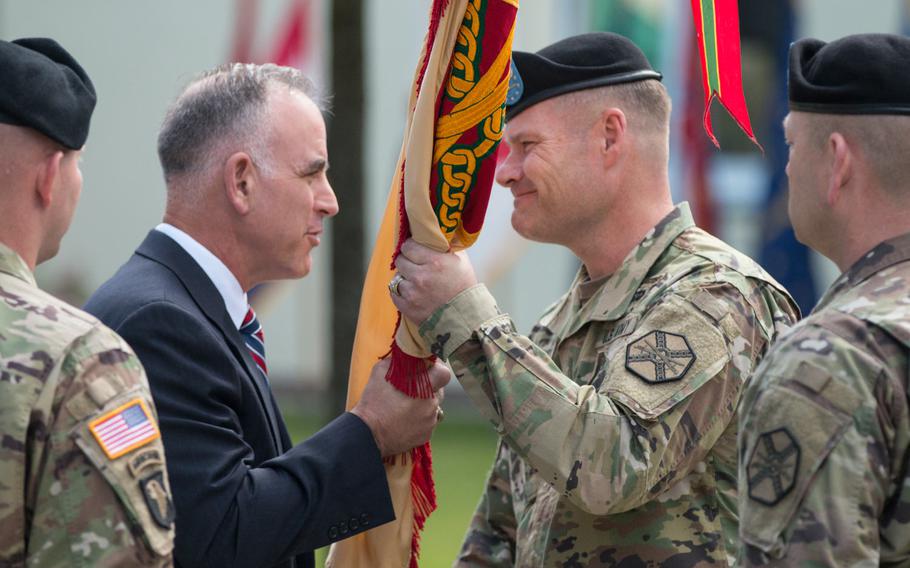
Michael Formica, left, director of Installation Management Command Europe, hands off the guidon to U.S. Army Garrison Bavaria's newest commander, Col. Lance Varney, during an assumption-of-command ceremony in Grafenwoehr, Germany, on Tuesday, July 5, 2016. (Michael S. Darnell/Stars and Stripes)
GRAFENWOEHR, Germany – During Col. Lance Varney’s assumption-of-command ceremony, the newest commander of U.S. Army Garrison Bavaria was reminded of his garrison’s strategic importance by Installation Management Command Europe’s director.
“As I look around, I see a few of us ... who were present during the old Reforger days,” Michael Formica said, referring to a series of NATO-led Cold War training exercises conducted in Europe from 1969 to 1993.
“Even though the Cold War is a memory, such training is still needed today. Our allies — some that once belonged to the Eastern bloc — now face a renewed threat from Russia,” he added.
Formica pointed to a host of exercises that have been conducted in response to Russia’s annexation of the Crimean Peninsula and its backing of separatists in eastern Ukraine.
Many of those exercises — such as last month’s Swift Response and the annual Combined Resolve — have taken place across USAG Bavaria’s scattered landscape. As a result, the garrison’s population has ebbed and flowed with troops both permanent and transient, American and foreign.
“This is the dynamic environment that Col. Lance Varney is now joining as the commander of garrison Bavaria and the military communities of Grafenwoehr, Vilseck, Hohenfels and Garmisch,” Formica said.
Varney takes over for the garrison’s interim commander, Col. Bill Rieper, who held down the fort after Col. Mark Colbook departed in June. Rieper will now continue on to European Command’s Russian Strategy Group.
Varney, a decorated soldier with five combat deployments under his belt, was fairly subdued in his first official remarks to his newest command.
“I’ve been stationed in Korea, Italy and France — but I have to say that the German-American relationships established here in Bavaria make this one of the most unique and rewarding locations to serve in the Army,” he said.
After the ceremony, Varney laid out what he views as the foundation of his command. It starts, he said, with formulating a creative strategy for success that works around limited resources and an ever-shifting geopolitical landscape.
Part of that strategy is to pull together elements from U.S. Army Europe, IMCOM and the Joint Multinational Training Command to form a “coherent plan that’ll help us through some of the transitions that we see.”